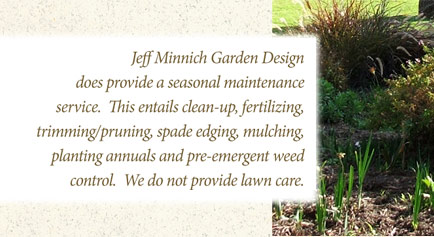|
|
|
|

- Staking/tying up—After this hideous winter, there is much to be staked and/or tied up. In some cases, it’s best to prune; in others, staking and tying are fine. I love the black, plastic, chainlock strap available at any garden center. It is strong and easy to use. It’s my tying-up tool-of-choice. It’s best done with two people—one to hold the branches in place and the other to tie. You can either tie the branches together within the shrub or stake it and tie it to pull it back into place. Many people have asked me if the branches/stems/trunks will regain their former strength…my answer is that I don’t know. I’ve never been through a winter like this, with this kind of damage, so I have no references. It will be interesting to see if bent plants gain enough strength to hold themselves up again.
- Fertilizing—The big feed on lawns is usually in the fall since that’s when it’s most beneficial. If you want to feed in the spring, a weed and feed product is good to hold back the broadleaf weeds. Also, don’t forget to put down pre-emergent crabgrass control ASAP—blooming forsythia is your signal to get busy on the crabgrass control. Shrubs, groundcovers, landscape plants—I usually only fertilize when I think a plant could use a boost…if a plant looks vigorous and healthy, I don’t bother. If I do, I like Woodace, Plant Tone, and Holly Tone. Old-fashioned 5-10-5 and 10-10-10 work well, too. These last two work well in the annual and perennial beds, too. You could also use well-rotted compost or manure for your vegetable and annual beds. For pots, use Osmocote. It’s time-released and lasts the season. On all these, follow the instructions on the sack so you don’t burn the plants. If your plants’ leaves are yellow with the green veins showing, they probably need iron…very common in plants like azaleas, gardenias, and other acid-loving plants. Use Ironite or a chelated iron product you can spray on.
- Edging and mulching—Re-edge your beds with a spade so they are nice and crisp, then mulch with no more than 2-3 inches of hardwood, pine bark or pine straw (needles). Hardwood mulch binds together best, so it won’t wash as much in hilly areas. The bigger the chip on the pine bark, the more it floats and the harder it is to plant annuals through it (you’ll find the trowel stabs the chips!!) Make sure you don’t have the mulch up against tree trunks and stems of plants…plants need to breathe and there is a lot of oxygen/carbon dioxide exchange going on where the trunk/stem meets the soil. If you have many layers of old mulch already in place, you may want to rake some of that out, or just very lightly top dress. Studies have shown that a too-deep mulch layer turns into a “false soil” layer; the roots of a plant will grow easily in this layer and not go deeply into the soil. This is not good because that thick mulch layer does not have the nutrients of the soil below. This can result in deficiencies…a common one is the iron deficiency I mentioned above.
- Weed prevention—We like to use a product called Preen on the beds after we mulch. It’s not a cure-all, but it sure does go a long way in helping to prevent weed growth. It’s a pre-emergent, so it zaps the weed seeds as they are beginning to emerge. And it will zap any seeds coming up, so not a good idea to use it in areas you are seeding, like vegetable and annual beds. Know this about the herbicide Round-up, too: it is non-selective, so if you spray to control weeds, it will kill EVERYTHING in its path. It’s a great product and works through the plant, not the soil, to kill it. Thus, it becomes inactive when it hits the soil, so you can immediately plant in an area sprayed with Round-up. But be careful what you hit when spraying. You don’t want to lose a prized plant.
- Planting times—It’s perfectly fine to plant all trees and shrubs now. We’ve started. We find it best to put perennials in after the ground has warmed a bit and the perennials have had a chance to get some growth on them. So we generally wait until late April/early May to start on the perennials. Annuals—pansies, snapdragons are fine now; the pansies decline when it gets hot. The tender things (most annuals) shouldn’t go in until the ground warms and the chance of frost has passed. This is on average April 25th in the DC area—later to the north and west, earlier to the south and east of the city. I wait until May 1 or so in my own garden. You will not gain anything by planting early for two reasons: the chance of frost; and the plants will sulk and not grow in too-cold ground. Vegetables—cool-season things can go in: broccoli, radishes and most root crops, greens, etc. Wait until May 1 or later for things like tomatoes, peppers, okra, corn, beans, etc. They like hot soil.
Let me know if you need any help with any of your gardening needs this year, including landscape design/installation/maintenance; patios/walks/walls; stone work; pots and container gardens; fencing; lighting; garden furniture and ornament; water features; irrigation, etc. etc. Most everything for the garden.
Next page > Winter Travels Los Angeles, Santa Barbara
|



